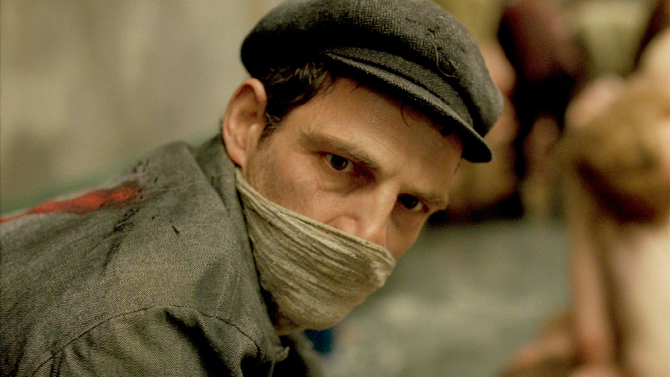Hungarian director and screenwriter László Nemes makes an astonishing debut – one of the greatest in recent memory – with the heart-rending and brutal Holocaust drama, Son of Saul.
Much to Nemes credit he manages to eschew all the usual clichés telling the story of Saul (Géza Röhrig, brilliant), a Hungarian Jew forced to help the Nazis in Auschwitz where he is a Sonderkommando. The Sonderkommando were workers made up of prisoners who, as an intertitle tells us at the beginning of the film, were considered “Geheimnisträger”, bearers of secrets. Saul’s hellish charge, burning the dead.
Nemes, capably sustained by cinematographer Mátyás Erdély, uses a subjective camera for the entirety of the film, and the audience is with Saul for the entire duration, adding immeasurably to the overall immersive experience.
Muscular long takes are choreographed intricately, in ways that sometimes obscure or soften the focus, causing fright, uncertainty, and anxiousness in the viewer, as harrowing sequence after harrowing sequence is piled one over the other. It’s a gut-wrenching, disorienting experience as well as a masterclass in formalist technique.
From the first frame as the focus tightens in on Saul it’s as if the viewer is plunged into the midst of maelstrom with an intensity few films can match, patently the work of a formidable stylist.
Between duties Saul witnesses a small boy barely survive the gas chamber only to die at the hands of a guard and he symbolically identifies with the boy as a son he lost, vowing to steal him before an autopsy can be performed, to bury him with a shred of dignity and have a rabbi say a blessing over him. A foolish notion, certainly, but Saul’s conviction is unwavering.
Given the setting, the color palette is a subdued and somber one, and largely nocturnal and underlit, Son of Saul is often chiaroscuro, and feels like a horror film.
The visuals, as methodical and imposing as they are, are made even more intuitive and airy when combined with sound designer Tamás Zányi’s intricate and terrifyingly efficacious approach. Zányi, incidentally, was awarded the Prix Vulcain de l’Artiste Technicien at Cannes for his efforts, where Son of Saul also rightly received the Grand Prix du Jury and the FIPRESCI Prize.
Röhrig gives a fearless and unforgettable performance, too. Maybe it’s that he bares a striking physical resemblance to François Truffaut, but his browbeaten amble and fractured grace recalls a cherubic quality that, once seen and raised, cannot be obliterated.
The film concludes in a more conventional manner, perhaps, than might be expected, in that it’s a flight to freedom – or maybe a fool’s errand – but remains gripping and tense, balancing suspense and narrative drive with emotional entanglement and an unerring sense of dread.
As Son of Saul moves inexorably towards a gruelling and suspenseful finish, it raises alarms and requires such intense tenacity that we understand, maybe fleetingly, the endurance and bravery of broken men. A masterpiece.
Taste of Cinema rating 4.5 stars (out of 5)
